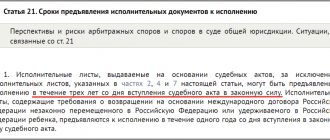To obtain a writ of execution from the court, you must submit an application for the issuance of a writ of execution according to the provided sample. There is no need to submit such an application separately if a court order is issued. The court order itself has the force of an executive document.
The court will issue a writ of execution after the decision enters into legal force. If the execution of a court decision is planned through the bailiff service, you can write an application for the court to send a writ of execution to the bailiff.
How to draw up an application for the issuance of a writ of execution
In the application for a writ of execution, it is necessary to indicate the applicant’s data, details of the court decision and state a request for the issuance of a writ of execution or sending it to the bailiff service directly by the court.
If several persons were involved in the case, or the execution of the court decision will be carried out at several addresses, then it is necessary to file an application with the court for the issuance of several writs of execution.
Now the Civil Procedure Code of the Russian Federation provides for the possibility of sending a writ of execution in the form of an electronic document signed with an enhanced qualified electronic signature of the judge. It is better to check with the secretary or assistant judge about the availability of this opportunity.
| If the writ of execution was previously issued, but was lost, the court is filed Application for the issuance of a duplicate writ of execution. |
Enforcement proceedings for dummies. First acquaintance with the bailiff service.
The lengthy trial is over, and you finally have a writ of execution in your hands, which you can present to the bailiff service for enforcement. Now you have turned from a plaintiff into a claimant.
First of all, having received a writ of execution in court, be sure to check the presence of all the necessary details, which are contained in Article 13 of the Federal Law “On Enforcement Proceedings” (hereinafter referred to as the “Law”).
In the event that some details are not in the writ of execution, you can rest assured that the bailiff will refuse to initiate enforcement proceedings on the basis of clause 4 of Art. 31 of the Law.
Most often, in practice, the year of birth of the debtor, the place of birth of the debtor is not indicated, or the place of birth of the debtor is indicated incompletely (for example, Moscow region, Moscow district - without indicating a specific locality). In case of incomplete indication of the place of birth, the bailiff considers that this mandatory detail is not indicated in the enforcement document.
It is recommended that when receiving a writ of execution in court, you check all its necessary details (I quote Article 13 of the Law):
1) the name and address of the court or other body that issued the executive document, the surname and initials of the official;
2) the name of the case or materials on the basis of which the executive document was issued, and their numbers;
3) the date of adoption of the judicial act, act of another body or official;
4) the date of entry into force of a judicial act, an act of another body or official, or an indication of immediate execution;
5) information about the debtor and claimant:
a) for citizens - last name, first name, patronymic, place of residence or place of stay, and for the debtor also - year and place of birth, place of work (if known);
b) for organizations - name and legal address;
c) for the Russian Federation, a subject of the Russian Federation or a municipality - the name and address of the body authorized on their behalf to exercise rights and perform duties in enforcement proceedings;
6) the operative part of a judicial act, an act of another body or official, containing a requirement to impose on the debtor the obligation to transfer funds and other property to the claimant, or to perform certain actions in favor of the claimant or to refrain from performing certain actions;
7) date of issue of the writ of execution.
In practice, questions may arise about subparagraph “b”, part 5 of Article 13 of the Law - the requirement to indicate the legal address.
The legislation does not contain such a concept as a legal address, but uses the term location of a legal entity. In order not to bother yourself, you need to know that the writ of execution must simply indicate the address of the legal entity, and what it is called, legal, actual or postal, has no practical meaning.
A very useful and important innovation of the Law is the ability of the claimant independently present a writ of execution for the collection of periodic payments (for example, alimony), as well as any other writ of execution for the collection of an amount not exceeding 25 thousand rubles. directly to the organization where the debtor receives wages, pension or other periodic income.
This innovation allows you to:
— the claimant promptly receives what is collected according to the writ of execution. For example, you know the debtor’s place of work. Now there is no need to “hand over” the writ of execution for the collection of alimony to the bailiff in order for him to forward it for retention to the debtor’s place of work;
- eliminates the ineffective workflow for researching the debtor’s property status by a bailiff (sending requests to registration authorities, foreclosure on property), which should have been undertaken earlier before sending a writ of execution for deduction from the debtor’s earnings (with the exception of collection of periodic payments).
Imagine this situation. Through the court, you recovered 10 thousand rubles from the debtor. Your debtor works at Russian Credit Bank.
Obviously, the debtor has wages. You present a writ of execution to the bank with your application, in which you ask the bank to deduct from the debtor 50% (the maximum amount of deductions) of his income. It is very likely that you will receive your ten thousand in one deduction. The writ of execution must be submitted to the organization by courier (i.e., against signature by the secretary of the organization or directly to the head), or by registered mail with notification.
As in the previous edition, the claimant, in accordance with Art. 8 of the Law, you have the right to send a writ of execution to the bank. This method is effective and is used in practice if your debtor is an existing legal entity and conducts financial and economic activities.
It is important to note that the collector does not need to know the specific current account number; it is enough to know only the bank where the debtor’s current account is located.
Simultaneously with the writ of execution, the claimant submits to the bank an application in which he indicates: - details of the claimant's bank account to which the collected funds should be transferred; - last name, first name, patronymic, citizenship, details of an identity document, place of residence or place of stay, taxpayer identification number (if available), details of the migration card and document confirming the right to stay (residence) in the Russian Federation of the claimant-citizen; - name, taxpayer identification number, state registration number, place of state registration and legal address of the claimant - a legal entity.
In this case, drawing up a collection order for legal entities (if the collector is a legal entity) is not required; one application is sufficient (clause 2 of Article 70 of the Law).
The bank forecloses on funds in the manner prescribed by Art. 70 of the Law. In accordance with paragraph 5 of Art. 70 of the Law, within three days from the date of receipt, the bank fulfills the requirements and, if there are insufficient funds, the bank continues to fulfill as received until full repayment.
The bank stops execution only in three cases (clause 10, article 70 of the Law): - after transferring funds in full; - at the request of the claimant; - by order of the bailiff on termination (completion, cancellation) of execution.
The issue of foreclosure on funds will be discussed in more detail below.
Also, the claimant always has the unconditional right to present a writ of execution to the bailiff without first going through the procedures described above.
To whom and how to send a writ of execution for enforcement? Bailiffs carry out their activities on a territorial basis, namely at the place of residence of the debtor.
That is, the writ of execution, as a general rule, must be presented to the territorial department that serves the area in which the debtor lives. For example, the debtor lives in the Leninsky district of Tver, the writ of execution must be presented to the Leninsky territorial department of bailiffs of Tver.
The same should be done if the debtor is a legal entity. In the event that you want to present a writ of execution at the location of a branch of a legal entity and the address of this branch is not contained in the writ of execution, you must attach evidence of the existence of such a branch at the specified address (this method of presentation is relevant when collecting from insurance companies, banks, and other organizations with a multi-branch network throughout the Russian Federation). Otherwise, the initiation of enforcement proceedings will be refused.
In accordance with Art. 33 of the Law “Place of execution of enforcement actions and application of enforcement measures,” the claimant has the opportunity to present a writ of execution at the location of the debtor’s property.
It is advisable to do this if most of the debtor’s property, especially real estate, is located at a remote distance from the debtor’s place of residence. The presence of the debtor's property in another territory must be indicated in the application to initiate enforcement proceedings and the relevant evidence must be attached (for example, a copy of the certificate of state registration of rights to real estate, etc.). Otherwise, the clerks of the territorial departments of the bailiffs will “kick you off at the authorities,” and the initiation of enforcement proceedings may be refused.
If we are talking about the fulfillment of requirements to perform certain actions (for example, “... oblige A.P. Ivanov not to interfere with the use of the water supply system located at such and such an address...”), then the writ of execution must be presented at the place where these actions were performed. This must also be indicated in the application to initiate enforcement proceedings. Initiation of enforcement proceedings is possible only on the basis of a written application from the claimant or his representative.
The powers of the representative are formalized in the usual manner - by a power of attorney, but it is important to note one feature - in the power of attorney, in addition to the usual powers of the representative, the power to present a writ of execution for execution must be specifically stipulated.
This requirement is contained in paragraph 3 of Art. 57 of the Law “Powers of representatives of parties to enforcement proceedings”. The following powers of the representative in enforcement proceedings must also be specifically stipulated: - presentation and withdrawal of the enforcement document; — transfer of authority to another person (subassignment); — appealing decisions and actions (inaction) of the bailiff; — receipt of awarded property (including cash and securities); — refusal of collection under a writ of execution; - conclusion of a settlement agreement.
The power of attorney (and not its copy - clause 2 of Article 30 of the Law) is attached to the application to initiate enforcement proceedings. An example of an application to initiate enforcement proceedings is given in the appendix.
It is useful in an application to initiate enforcement proceedings to request the seizure of the debtor’s property in order to ensure compliance with the requirements of the enforcement document. This will allow the bailiff to seize the debtor’s property, incl. within the period established for voluntary execution by the debtor, immediately simultaneously with the delivery of the resolution to initiate enforcement proceedings.
In addition, you can indicate the application to the debtor of a temporary restriction on leaving the Russian Federation (Article 67 of the Law). By the way, this enforcement action is traditional for Russian legislation, so in pre-revolutionary law, the bailiff could prohibit the debtor from leaving his place of residence (and not the borders of the Russian Empire in general - author’s note)
If you have any valuable additional information about the debtor, then it must be indicated in the application to initiate enforcement proceedings. It is even better if it is possible to draw up a joint action plan with the bailiff, and also if you have the opportunity to assist the bailiff in carrying out enforcement actions and applying enforcement measures (providing vehicles for transporting seized property, storage space for property, loaders, etc.). The likelihood of quick and complete compliance with the requirements of the writ of execution in such cases increases significantly.
The collector must always remember one simple thing - his role in debt collection must be extremely active.
If you are a debtor , then you also need to know several important rules. Every debt is returned ®. The natural course of things is that the debtor is not eager to pay the debt, otherwise the matter would not have reached the bailiffs. There are cases when the debtor takes a principled position not to pay, because considers the court's decisions illegal and unfair. This category of debtors is the most difficult for a bailiff.
The simplest tactic that a debtor can choose is the tactic of passive defense. What is it? Do not receive correspondence, do not open the door to the bailiff, hide, “transfer” all property to other persons.
However, the use of this tactic is effective only at some stage. The new version of the law on enforcement proceedings has closed many loopholes for the debtor.
Chapter IV of the Law “Notification and Summons in Enforcement Proceedings” contains a set of legal norms that makes the tactic of not receiving correspondence ineffective. In accordance with clause 3. Art. 24 of the Law, the notice is sent to the address indicated in the enforcement proceedings or at the place of work.
That is, if the debtor is officially employed, then he will not be able to avoid receiving correspondence. In case of evasion of appearing when called, the debtor may be forcibly brought in (you must agree that this is an unpleasant procedure when you are “led away” by people in uniform in the presence of work colleagues).
If the debtor changes his place of residence, he is obliged in accordance with Art. 28 of the Law, inform the bailiff department about the change of your address. If there is no such message, then all correspondence is sent by registered mail to the last known address of the specified person, and he is considered notified, even if he no longer resides or is located at this address.
A person participating in enforcement proceedings (including the debtor), in accordance with paragraph 2 of Art. 29 of the Law, is considered notified if: - the addressee refused to receive a summons or other notice; - despite receiving a postal notice, the addressee did not appear for a summons or other notice sent to his address.
That is, during enforcement proceedings, receiving correspondence is the debtor’s problem, and if he simply does not receive it, then this does not give him any advantages.
“Rewriting” the property of other persons, of course, makes it impossible to foreclose on it. However, here the debtor receives another group of risks - how reliable are the persons to whom the property is re-registered. In practice, there are cases when people thus gave away their property for nothing.
In addition, at present, bailiffs are actively using procedures to recognize transactions for “rewriting” property as invalid (imaginary).
I once covered this issue in the article “Dispossession of property in enforcement proceedings,” which can be found, for example, at this link
Application
In Leninsky (Frunzensky, etc.) ROSP, Moscow st. Bagaeva, 27
from Ivanov Ivan Ivanovich
living Moscow st. Ivanovskaya 1, apt. 1
Application for initiation of enforcement proceedings
I ask you to accept for forced execution the writ of execution issued on the basis of the decision of the Leninsky District Court of Moscow dated January 1, 2001. in case No. 1-11, about the recovery from the debtor Petrov Petr Petrovich, living at the address: Moscow, st. Petrovskaya, 1, apt. 1, a sum of money in the amount of 1000 rubles in my favor, and initiate enforcement proceedings.
Simultaneously with the initiation of enforcement proceedings, I request that the debtor’s property be seized in order to ensure compliance with the requirements of the enforcement document.
Date 01/01/2010 ________________________ (Ivanov I.I.)
Note
1. The writ of execution is presented by the claimant. In this case, the person accepting the writ of execution verifies the identity of the presenter by checking identification documents (passport; for military personnel - identity card). Driver's licenses and various types of identification documents are not identification documents.
2. In the case of presentation of a writ of execution by a representative of the claimant, it is necessary to have a genuine power of attorney drawn up in accordance with current legislation.
Unlock access to the private part of Clerk with a Premium subscription. Get hundreds of webinars and online courses, unlimited consultations and other proprietary content for accountants.
Hurry up to subscribe with a 20% discount until October 15, 2021. Read more about “Premium” here.
Submission and consideration of an application for a writ of execution
An application for the issuance of a writ of execution is submitted to the court that made the decision. If the decision was changed or canceled by a higher court, the application for a writ of execution is still submitted to the court of first instance. Since it is in the first instance that the civil case is kept.
You can submit an application at any time after the decision comes into force. Such applications are not subject to state duty.
The judge considers the issue of issuing a writ of execution without holding a court hearing or summoning the parties. However, in complex cases, in order to eliminate contradictory or conflict situations, the judge may schedule a court hearing, with a ruling on the application for the issuance of a writ of execution. This is more often practiced when the court refuses to issue a writ of execution.
After receiving the writ of execution form, the claimant can present it to the bailiff service, along with an application to initiate enforcement proceedings.
Application example
To the Kamyzyaksky District Court
of the Astrakhan Region
Claimant: Krivogornitsina Egor Alekseevich,
address: 416340, Astrakhan region,
Kamyzyak, st. Rossiyskaya, house 220
tel. 4687987985
within the framework of case 2-498/2021
Application for issuance of a writ of execution
On October 17, 2021, the Kamyzyaksky District Court of the Astrakhan Region made a decision in case No. 2-498/2021 on unjust enrichment. By a court decision that entered into legal force on November 20, 2021, the demands of Krivogornitsin E.A. to Shustov S.V. partially satisfied. In my favor, the amount of 115,000 rubles was recovered from the defendant.
The defendant does not want to voluntarily comply with the court decision, citing a lack of financial resources. Execution of a court decision is possible only forcibly, through the bailiff service.
Guided by articles 428-429 of the Code of Civil Procedure of the Russian Federation,
Ask:
- Issue a writ of execution by court decision dated October 17, 2021 in civil case No. 2-498/2021 in accordance with the claim of E.A. Krivogornitsin. to Shustov S.V. on the recovery of unjust enrichment.
12/10/2021 Signature Krivogornitsin
Issuance of a writ of execution
According to the Instructions for Office Work, a writ of execution must be issued no later than the next day after the court decision in the case comes into legal force. Accordingly, after submitting an application for the issuance of a writ of execution, you should receive it on the same day, or at most on the next business day, if it has not yet been issued.
In some cases, a writ of execution is issued immediately after a court decision is made. In this case, it is necessary to demand its issuance on the same day after the court’s decision is announced.
Writs of execution are immediately issued for the following applications:
- on the collection of alimony
- collection of wages - for the last 3 months
- about reinstatement
In other cases, the court order seeks immediate execution at the request of the plaintiff.
Note:
Application for immediate execution of a court decision
What to do if the bailiff does not allow you to familiarize yourself with the case materials?
Refusal to familiarize yourself with the materials of enforcement proceedings is also possible. You may be refused in three cases:
- you may be denied access to the enforcement proceedings only if the case is not filed and will not be given to you;
- you may receive a refusal if you do not have the right to familiarize yourself with the proceedings, for example, you are only distant relatives of the persons involved in the case in the absence of a power of attorney (in addition, the presence of a power of attorney is not a 100% obligation on the part of the bailiff to give the case, because he will check the terms of reference specified in text, will refuse if there is no right to access enforcement proceedings);
- the last option is if the application for review was drawn up incorrectly or gross errors were made regarding the specification of the production, and therefore completely different materials were prepared for review. By the way, don’t forget to sign the application - the absence of a signature on the document can also become grounds for refusal, albeit a formal one.
If the right to familiarize yourself with the proceedings is violated by the bailiff illegally or he delays making a decision on your application, then a complaint against the actions of the bailiff will solve the problem, the complaint can be submitted either to a superior or to the court, for more details on how to correctly file a complaint against the bailiff, follow the link .
Form and form of the writ of execution
The writ of execution is issued according to the form of the writ of execution form established and approved by Decree of the Government of the Russian Federation No. 579 of July 31, 2008. The same regulatory act approved the rules for the production, storage and recording of writs of execution.
Forms of writs of execution are made on special paper with watermarks and protection against counterfeiting. Each form of the writ of execution has its own series and number, which are printed in the printing house.
Download:
Rules approved by Government Decree No. 579 of July 31, 2008
Form of writ of execution








